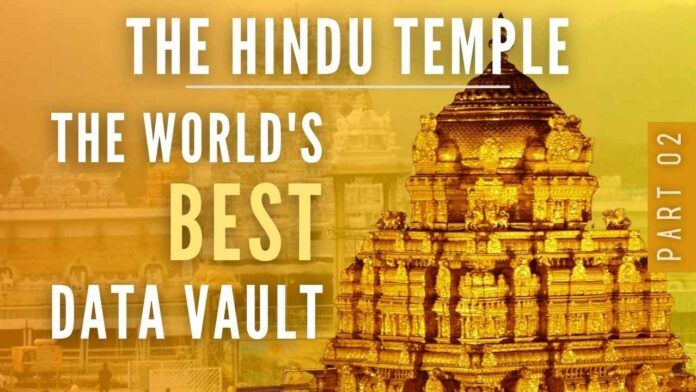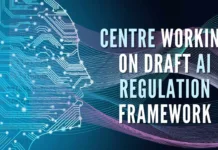
How Hindu temples can be Data Engineered to create the world’s best Demographic Data Vault
In the previous article, I stated why we need to replace census with Demographic Data Engineering. The fundamental reason why we need to do this is to get the accurate number of people in every religious denomination (especially the Hindus) at a particular time because the census numbers can be manipulated and are very much deceiving.
The census captures one-time static info regarding the faith but the faith of an individual is subject to change, transition, and movement which may or may not be induced and the rate at which it can be transient in the modern world makes it a clear case that census will hold no use.
In today’s world, data is ‘the next generation oil’ that will fuel the planet, it is no more the middle east which will dominate based on a particular resource, or will it be the United States of America that will dominate based on military technology.
Data is the fuel and the fundamental block which will aid in the minutest policy decision to drive the implementation of Artificial Intelligence (AI) in the future, whoever owns it (individual or entity), whichever country dominates a great hold on data will dominate the world. This is the prime reason why there is so much paranoia regarding social media and tech companies across the globe.
People do have apprehensions that data ending up with the wrong ones might kick start a neo-colonialism led by the tech firms or by their promoters whose cultural & political beliefs are unknown.
From my understanding, colonialism viewed from the dimension of political aspects took place because of 3 main reasons:
- The colonizers knew how to pitch one ruler over the other by entering the political battleground masquerading as tradesmen.
- Advanced technology fueled by the Industrial revolution thereby giving an edge.
- Discriminating one ruler over another thereby undermining collective sovereignty.
Today the same patterns are visible wherein the colonizers are the social media tech firms and we as a society are the rulers and the next-gen industrial revolution is the data.
We as a country have been gifted with a large population, a large, young, dynamic, and ever-growing awareness-oriented population. This means that there is a high potential from which data can be mined from the demographics of this country, however, the data that is mined should be with the right ones.
The weaponization of data is possible at large levels, we saw how social media tech companies with liberal left-leaning ideology were able to influence US elections in 2020. They went to the extent of even banning the former president of the US Mr. Donald Trump bypassing the fundamental right to speech and expression enshrined in the US constitution.
The tech companies have shown that military might and enormous powers vested in the president are nothing when compared to the data that they possess. The US 2020 elections are a testament to the fact that the power to influence a large group of people in a short time is possible with the help of data.
For a country like the United States, it is the political ideology of the tech companies that stood as the factor to influence but in India, the political ideology of tech companies would not be the sole factor but a complex of ideology, faith, community, and culture.
We have already seen that the tech companies have a leaning to the left ideology but the left ideology of the US is not the same as that of the left ideology of our country. We must understand that the left ideology in the US is simply extreme left-liberal in nature (but funded by capitalists) whereas in India it is a collection of terror + Hinduphobic propaganda + minority appeasement + anti-Brahmin sentiment along with the existing hatred for anything that is native or having significance to the cultural identity of this country.
All these are promoted day in and out with a systematic pattern of targeting one group over the other. Social media can become a platform to mass polarize one community over the other and normalize such patterns to enable user engagement and further the gap of disunity and thus promote religious proselytization.
The best way to handle the upcoming challenge is to ensure that the data sovereignty of the Hindus is made a necessity & guarantee as the demographics, beliefs, and culture of one group can be exploited to fuel clashes.
These neo-colonizers can fuel disunity between the Hindu society because they are at an advanced stage of data-enabled polarization (similar to the colonizers who knew what the native rulers’ motives were and what they wanted to hear).
We need to understand that the next generation challenge of neo-colonizers can be fought only with the help of Demographic Data Engineering of Hindu and Dharmic Institutions. The neo-colonizers have sufficient data at their disposal while the Hindu society as of now doesn’t even own fundamental blocks to self-introspect, the Hindu society is simply not aware of what a live streamlined continuous flow of data can do.
Hindu society is unaware of who is the target group of these colonizers so it is a necessity to stand up and self-analyze. This is necessary not just to combat internal strifes but also to have a check on where exactly the society is being lured into proselytization. Eg. Is there a higher chance of proselytization based on one’s income or which ethnic group is more lured to conversion etc?
There is only one place where Hindus can organize themselves and collectively self-introspect and self-analyze their needs and mitigate the upcoming challenges, the Hindu Temple. Our ancestors build temples as a point of congregation for the body with mind and spirit, now that congregation needs to be upgraded with data which is for us to analyze.
The Hindu Temple is one mighty institution whose potential seen from the aspect of demographic data is unexplored and untapped. The footfall (or rather the namaskars) at a Hindu Temple every day across the country can be transformed into an ocean of recurring valuable demographic data.
No mall or any place in the world has footfalls like our Hindu temples and to date, no data gathering, no profiling, no value addition has been done in the Hindu temple. It can act as a single point of the world’s largest crowd-funding program.
In India, to travel in a metro we need RFID enabled cards, to travel in a flight we need PAN card/ identity card, to use several mobile applications, so many details we readily give to companies for them to analyze and do profiling so that they can decide how they can grow the business but for visiting our priceless Hindu temples we don’t need to give anything nor do we need to carry anything nor are they checked.
For once in our lifetime if Hindus decide collectively that they will enable securitization of faith with the help of their data we can thwart the external forces who are all set to play at the fragilities of our society.
The first step in this process which needs to be done is to streamline and digitize the Hindu temples and Dharmic institutions across the country. By digitization, the data vault of devotees, especially the Hindus must be brought to life and be put to use.
In recent times, the supply chain e-commerce/ B2B boom started when the data of various retail stores, their footfalls, and the average GMV (Gross mercantile value) was captured and analyzed thereby resulting in optimization & resource mobilization, leveraging the same process, Hindu devotees data gathered from across the temples would help us in identifying & solving major issues from a non-commercial aspect.
A comprehensive amount of data of people or devotees should be gathered every time they enter the temple premise in a hassle-free automated manner to ensure security & sanctity.
Why do we need this?
We need to do this to know the actual number of practicing Hindus and at the same time, we need to verify if those entering the premise are Hindus. In my previous article, I explained the concept of SCD (Slowly Changing Dimension).
Also, The reason why we need to do is not solely tied to finding out the count but to holistically look at the data from the security, the sanctity of the premise as well. The temple is not a secular institution its premises just cannot allow someone from another faith inside it when such the faith of such an individual openly calls it as Kafir or Satan.
Recent events have shown that people from other faiths have even started doing proselytization within temple premises and there was even an incident where namaz was performed inside Mathura Temple. This data gathering and profiling is for the safety of the Hindu society at large.
This data gathering of devotees can be done in two ways one is through an application, specifically a mobile application, and for those who don’t have access to mobiles, through the issuance of Hindu devotee cards.
This kind of experiment is already in practice at a very preliminary level which is for TTD – Tirumala Tirupati Devastanam darshan via internet booking. This system is now in several temples in the state of Andhra Pradesh but hardly people go through this route.
This internet booking captures comprehensive information of the devotee just as any other online travel website however no system is in place to verify whether the person who registers himself as Ravikumar is Ravikumar or Robert Fernandez. Countless impersonation instances have gone unchecked in temples and this can be solved with a verification process.
If the VIP darshan in every temple can be put through scrutiny to check impersonations then definitely the normal darshans should be subject to the same level of scrutiny.
Also, This is to help the Hindus understand their collective needs as a society from the house of the presiding deity itself. Eg. Crowdfunding of orphaned Hindu students or widows can be done without any intermediaries.
We have also seen that people cooperate if there is a crisis, this was seen recently during the COVID-19 breakout. People who wanted to visit a particular place eg. An Airport, had to register themselves with the Aarogya Setu app, and also had to get themselves vaccinated only then were they permitted. We achieved the great feat of vaccinating a large group of people in a short time and vaccination completion cards were issued in remarkable time.
Similarly, at major temples, we need to bring in an application that scrutinizes the entry. The devotees should be given a pan India temple devotee card without which they should not be permitted into the premises. The devotee cards should capture comprehensive details regarding the devotee and the data should be encrypted and stored in a repository or a warehouse preferably a secured private cloud.
We do not need to do this for all the temples but just 10 major temples where the footfall is heavy, why only 10 is because the data capture can be done within the time it takes for the darshan and these 10 would be sufficient for us to set the ball rolling. Additional temples can be brought in a phased manner.
In Tirupati temple it takes an average of 2 hours (in the queue) for the darshan, the demographic data required of a devotee can be captured in 10-15 mins but an exclusive team should be present for this as language and other barriers do exist but these operational challenges and can be overcome by an SPV (Special purpose vehicle) to monitor the entire process.
The app-based is a self-attested process similar to but needs additional information. Our own country’s AI-based startups such as ‘Hyperverge’ have made it possible for seamless onboarding of new telecom customers where the identity verifications are done by the app itself so we can leverage several novel technologies to successfully bring in as many devotees into the pipeline and also parallelly issue devotee cards through an SPV.
When we have combined the data of both the app-based plus the devotee card route we will have a repository of data that can then be securitized.
In part 3, we will see how the applications can work once we have a live-running repository…
To be continued…
Note:
1. Text in Blue points to additional data on the topic.
2. The views expressed here are those of the author and do not necessarily represent or reflect the views of PGurus.
PGurus is now on Telegram. Click here to join our channel and stay updated with all the latest news and views
For all the latest updates, download PGurus App.
- Bharat must bring back the world’s renowned empire builders – The Zoroastrians (Parsis) deserve a permanent global Indian citizenship & permanent representation in the Lok Sabha - June 23, 2022
- Hindu State Part 3: The Hindu State is possible with the synergy of 4 wings of Hindutva – Street Hindutva, Intellectual Hindutva, Tech Hindutva, and Virat Hindutva on stand-by - May 1, 2022
- The Hindu Vivaaha: A prosperity enhancing ceremony under siege, why educated Hindu youth should understand the financial & economic advantage of getting married young - February 18, 2022










